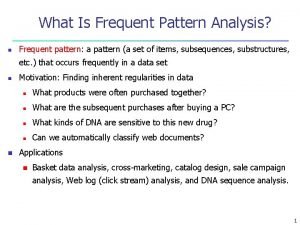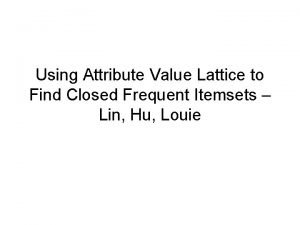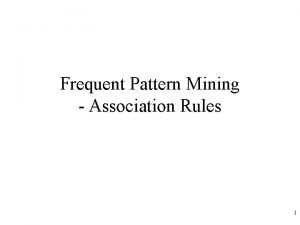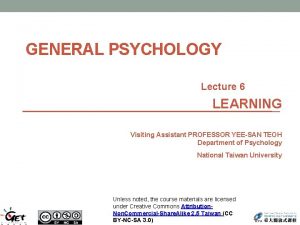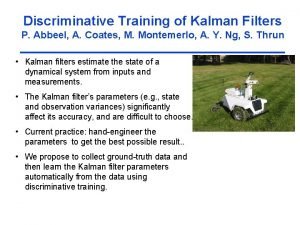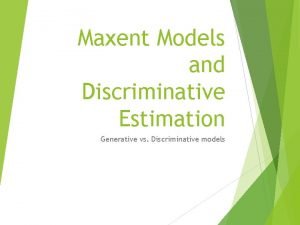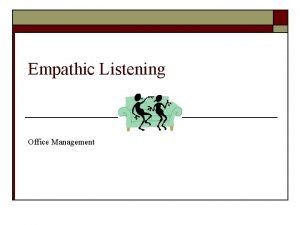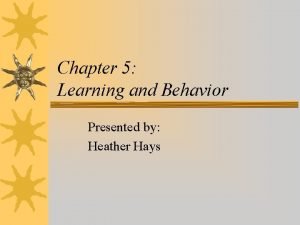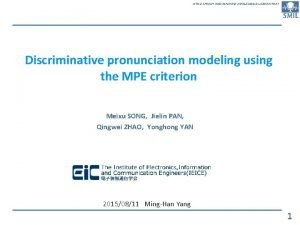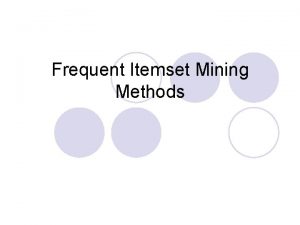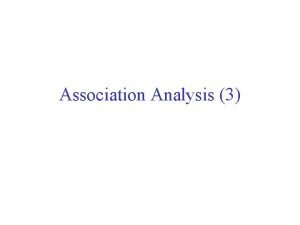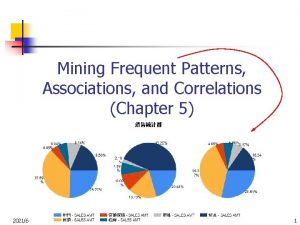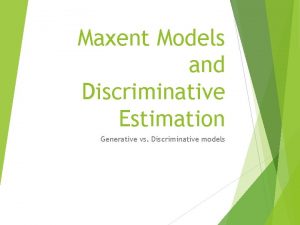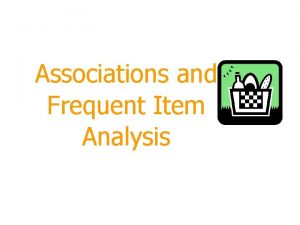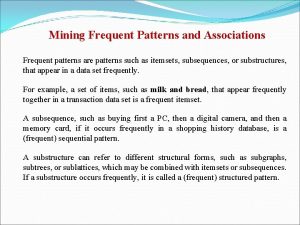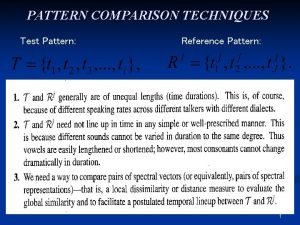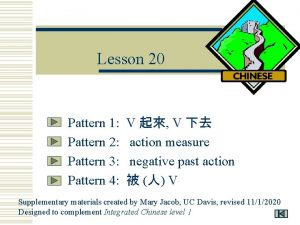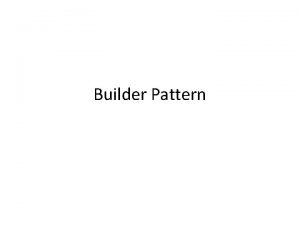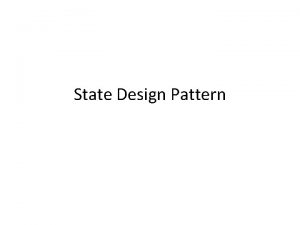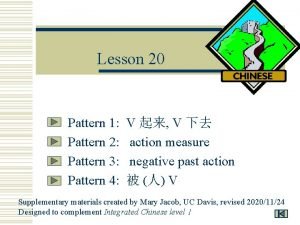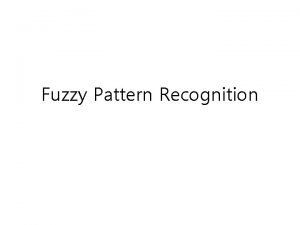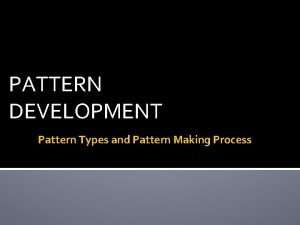COURSE PRESENTATION Discriminative Frequent Pattern Analysis for Effective






















- Slides: 22

COURSE PRESENTATION: Discriminative Frequent Pattern Analysis for Effective Classification Presenter: Han Liang 1

Outline Motivation n Academic Background n Methodologies n Experimental Study n Contributions n 2

Motivation v v Frequent patterns are potentially useful in many classification tasks, such as association rule-based classification, text mining, and protein structure prediction. Frequent patterns can accurately reflect underlying semantics among items (attribute-value pairs). 3

Introduction v v This paper investigates the connections between the support of a pattern and its information gain (a discriminative measure), and it also proposes a pattern selection algorithm. The generated frequent patterns can be used for building high quality classifiers. Experiments on UCI data sets indicate that the frequent pattern-based classification framework can achieve high classification accuracy and good scalability. 4

Classification – A Two-Step Process Step 1: Classifier Construction: learning the underlying class probability distributions. > The set of instances used for building classifiers is called training data set. > The learned classifier can be represented as classification rules, decision trees, or mathematical formulae (e. g. Bayesian rules). Step 2: Classifier Usage: classifying unlabeled instances. > Estimate accuracy of the classifier. > Accuracy rate is the percentage of test instances which are correctly classified by the classifier. > If the accuracy is acceptable, use the classifier to classify instances whose class labels are not known. 5

Classification Process I – Classifier Construction Classification Algorithms Training Data NAME RANK YEARS TENURED Mike Assistant Prof 3 No Mary Assistant Prof 7 Yes Bill Professor 2 Yes Jim Associate Prof 7 Yes Dave Assistant Prof 6 No Anne Associate Prof 3 No Learned Classifier IF rank = ‘Professor’ OR years > 6 THEN tenured = ‘Yes’ 6

Classification Process II – Use the Classifier in Prediction Learned Classifier IF rank = ‘Professor’ OR years > 6 THEN tenured = ‘Yes’ Test Data NAME RANK YEARS TENURED Tom Assistant Prof 2 No Merlisa Associate Prof 7 No George Professor 5 Yes Joseph Assistant Prof 7 Yes Russ Associate Prof 6 Yes Harry Professor 3 Yes Unseen Data (Jeff, Professor, 4) Tenured? 7

Association-Rule based Classification (ARC) Classification Rule Mining: discovering a small set of classification rules that forms an accurate classifier. > The data set E is represented by a set of items (or attribute-value pairs) I = {a 1, …an} and a set of class memberships C = {c 1, . . cm}. > Classification Rule: X => Y, where X is the body and Y is the head. > X is a set of items (a sub set of I, denoted as X I). > Y is a class membership item. > Confidence of a classification rule: conf = S(X Y) /S(X). > Support S(X): the number of training instances that satisfy X. 8

ARC-II: Mining - Apriori Generate all the classification rules with support and confidence larger than predefined values. > Divide training data set into several subsets; one subset for each class membership. > For each subset, with the help of on-the-shelf rule mining algorithms (e. g. Apriori), mines all item sets above the minimum support, and call them frequent item sets. > Output rules by dividing frequent item sets in rule body (attribute-value pairs) and head (one class label). > Check if the confidence of a rule is above the minimum confidence. > Merge rules from each sub set, and sort rules according to their confidences. mining pruning classification 9

ARC-III: Rule Pruning Prune the classification rules with the goal of improving accuracy. > Simple Strategy: > Bound the number of rules. > Pessimistic error-rate based pruning. > For a rule, if we remove a single item from the rule body and the new rule decreases in error rate, we will prune this rule. > Data set coverage approach. > If a rule can classify at least one instance correctly, we will put it into the resulting classifier. > Delete all covered instances from training data set. mining pruning classification 10

ARC-IV: Classification Use the resulting classification rules to classify unseen instances. > Input: > Pruned, sorted list of classification rules. > Two different approaches: > Majority vote > Use the first rule that is applicable to the unseen instance for classification. mining pruning classification 11

The Framework of Frequent-Pattern based Classification (FPC) v Discriminative Power vs. Information Gain v Pattern Selection 12

Why Are Frequent Patterns Useful? > Frequent Pattern - A non-linear combination of single features. - Increase the expressive (or discriminative) power of the feature space. * Exclusive OR example. * Data is linearly separable in (x, y, xy), but not in (x, y) X Y C 0 0 1 1 1 0 Transform X Y XY C 0 0 0 1 1 0 Linear classifier: f = x + y - 2 xy

Discriminative Power vs. Information Gain - I The discriminative power of a pattern is evaluated by its information gain. Ø Pattern based Information Gain: > Data set S is divided into several sub sets, and each sub set is corresponding to a class membership. S can be denoted as S = {S 1…Si…Sm}. > For a pattern X, S is divided into two subsets: the group where pattern X is applicable and the group where pattern X is rejected. (binary splitting) > The information gain of pattern X is calculated via: where I(S 1, S 2, …Sm) is represented by: and E(X) is computed by:

Discriminative Power vs. Information Gain - II > To simplify the analysis, assume pattern X {0, 1} and C= {0, 1}. Let P (x=1) = , P (c=1) = p and P (x=1|c=1) =q. > Then, can be instantiated as: where and q are actually the support and confidence of pattern X.

Discriminative Power vs. Information Gain - III > Given a dataset with a fixed class probability distribution, I(S 1, S 2, …Sm) is a constant part. > After mathematical analysis, we draw the following two conclusions that: > A pattern with a low support has a low discriminative power measured by information gain. It will harm classification accuracy because it will over-fitting the training data. > A pattern with a very high support also has a low discriminative power measured by information gain. It is useless for improving classification accuracy and will increase the bias. > Experiments on UCI datasets. The X axis represents the support of a pattern and the Y axis represents the information gain. We can clearly see that both low-support and very highsupport patterns have small values of information gain. Austral Sonar

Pattern Selection Algorithm MMRFS v Relevance: A relevance measure S is a function mapping a pattern X to a real value. It benchmarks how much pattern X is relevant to the class label. > Information gain can be used as a relevance measure. > A pattern can be selected if it is relevant to the class label measured by IG. v Redundancy: A redundancy measure R is a function mapping two patterns X and Z to a real value such that R (X, Z) is the redundancy value between them. > Mapping function: > A pattern can be chosen if it contains very low redundancy to the patterns already selected. 17

Pattern Selection Algorithm MMRFS-II v v The algorithm searches over the pattern space in a greedy way. At first, a pattern with highest relevance value (information gain value) is selected. Then the algorithm selects more patterns from F one by one. A pattern is chosen if it has the maximum gain among the remaining patterns F-Fs. This gain is calculated by: The coverage parameter is set to ensure that each training instance is covered at least times by the selected patterns. In this way, the number of patterns selected is automatically determined. 18

Experimental Study v v Basic learning classifiers – used to classify unseen instances. > C 4. 5 and SVM For each dataset, a set of frequent patterns F is generated. > A basic classifier, which is built based on all patterns in F, is called Pat_All. > A basic classifier, which is built based on a set of selected features Fs, is called Pat_FS. > For comparisons, the authors also include the basic classifiers which are built based on all single features, called Item_All, and a set of selected single features, called Item_FS. Classification Accuracy. All experimental results are obtained by use of ten-fold cross validation. 19

Experimental Study-II v v Table 1 shows the results by SVM. Pat_FS is better than Item_All and Item_FS. This conclusion indicates that: > the discriminative power of some frequent patterns is higher than that of single features. v Pat_FS is better than Pat_All. This confirms that: > redundant and non-discriminative patterns will make classifiers over-fit the training data and decrease the classification accuracy. v The experimental results by C 4. 5 is similar to SVM’s. 20

Contributions v v v This paper propose a framework of frequent pattern-based classification, by analyzing the relations between pattern support and its discriminative power. It shows that frequent patterns are very useful for classification. Frequent pattern-based classification can use the state-of-the-art frequent pattern mining algorithm for pattern generation, thus achieving good scalability. An effective and efficient pattern selection algorithm is proposed to select a set of frequent and discriminative patterns for classification. 21

Thanks! Any Question? 22
 Crm process in retailing
Crm process in retailing Maximal and closed frequent itemsets
Maximal and closed frequent itemsets Closed pattern and max pattern
Closed pattern and max pattern Closed frequent pattern
Closed frequent pattern Closed frequent pattern
Closed frequent pattern Frequent pattern
Frequent pattern Reinforcement graph
Reinforcement graph Discriminative stimulus psychology definition
Discriminative stimulus psychology definition Discriminative training of kalman filters
Discriminative training of kalman filters Response class vs stimulus class
Response class vs stimulus class Discriminative listening
Discriminative listening Generative vs discriminative models
Generative vs discriminative models Discriminative listening
Discriminative listening Empathic listening meaning
Empathic listening meaning Discriminative stimulus
Discriminative stimulus Laboratory pronunciation
Laboratory pronunciation Discriminative listening definition
Discriminative listening definition Appreciative listening
Appreciative listening Generative vs discriminative
Generative vs discriminative Icd 10 metroragia
Icd 10 metroragia Apriori algorithm
Apriori algorithm Acegd
Acegd Associations and correlations in data mining
Associations and correlations in data mining


